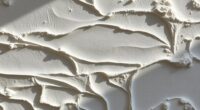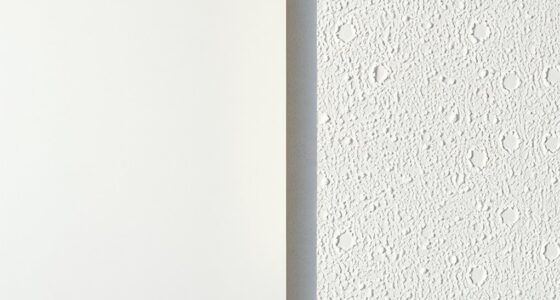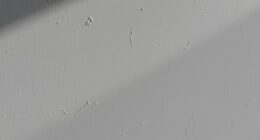To prevent peeling paint caused by moisture in your walls, start by identifying and fixing leaks from basements, roofs, or plumbing. Improve ventilation with fans or open windows, and use dehumidifiers to keep humidity levels low. Before painting, clean and sand surfaces, then apply a high-quality primer to seal moisture-prone areas. Regularly inspect and maintain your walls to catch issues early—keep exploring for more solutions to protect your home long-term.
Key Takeaways
- Identify and fix leaks or water intrusion sources to prevent moisture buildup behind walls.
- Ensure proper surface preparation, including cleaning, sanding, and sealing with high-quality primer before painting.
- Maintain adequate ventilation and use dehumidifiers to control indoor humidity levels and reduce wall moisture.
- Install vapor barriers and proper insulation to limit moisture transfer and condensation within wall cavities.
- Regularly inspect walls for signs of dampness, mold, or peeling paint, and address issues promptly to prevent further damage.
Recognizing Signs of Excess Moisture in Your Home
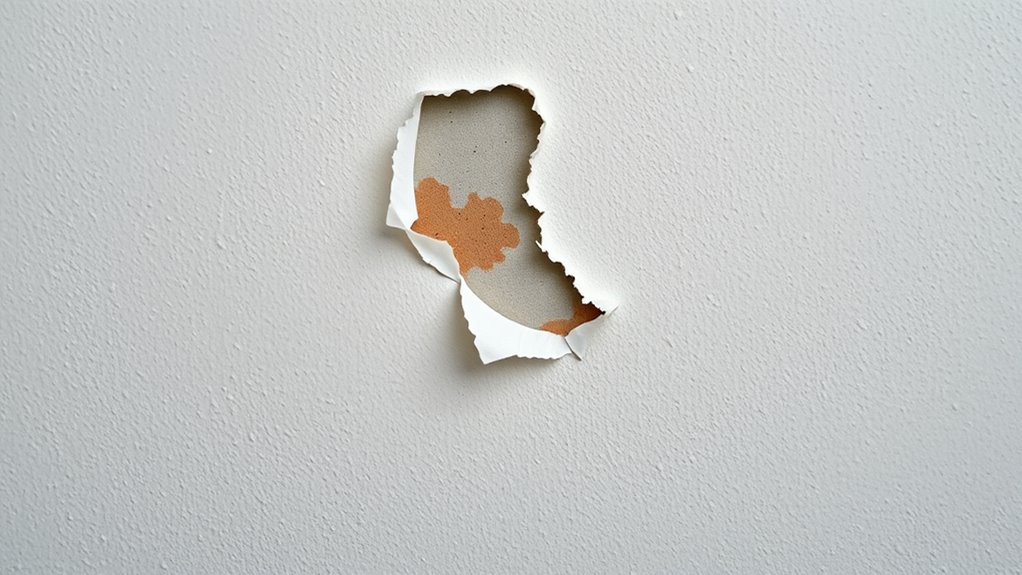
Excess moisture in your home often shows up in subtle yet noticeable ways. You might notice a persistent dampness or a musty smell that lingers in certain rooms. Look for peeling paint or wallpaper, which can be early signs of moisture buildup behind the walls. Improving ventilation helps reduce humidity levels, making your space less inviting for mold growth. Additionally, upgrading insulation can prevent warm, moist air from condensing inside walls, which often leads to water stains and peeling paint. Keep an eye on condensation around windows or on walls, especially during colder months. Recognizing these signs early allows you to take proactive steps, like enhancing ventilation or insulation, to keep moisture levels in check and protect your walls from damage. Being aware of building materials and their susceptibility to moisture can also help in selecting the right solutions for your home. Proper maintenance and understanding of industry trends can further aid in preventing long-term issues caused by excess moisture, such as improved moisture control techniques and materials. For example, incorporating water-resistant paints can provide an additional layer of protection against moisture intrusion.
Common Sources of Wall Humidity and Water Intrusion
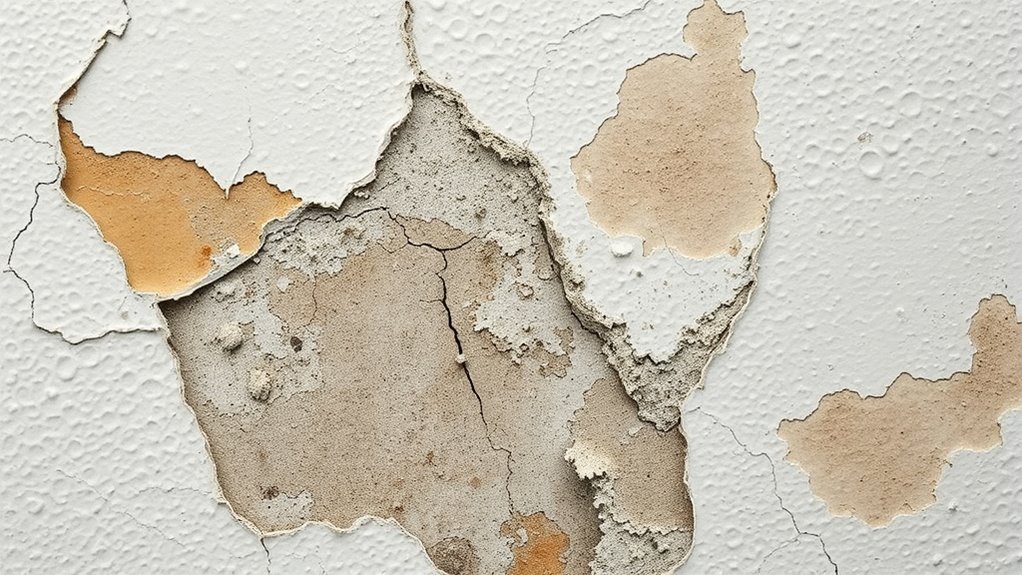
Identifying the common sources of wall humidity and water intrusion is essential for preventing long-term damage to your home. Basement leaks are a frequent culprit, often caused by cracks in walls or poor drainage around the foundation. Water seeping through these gaps can lead to persistent dampness and mold growth. Roof condensation is another major source; during colder months, warm indoor air contacts cold roof surfaces, causing moisture to form and drip down walls. Poor insulation or ventilation can worsen this problem. Additionally, plumbing leaks or faulty gutters can channel water into walls, accelerating deterioration. Recognizing these sources early helps you take targeted action to prevent peeling paint, mold, and structural issues, ensuring your home stays dry and healthy. Proper Building envelope integrity can also significantly reduce water intrusion risks. Understanding water intrusion mechanisms can further enhance your ability to address these issues effectively. Sharing homeownership experiences can inspire proactive maintenance and help families cherish their living spaces despite challenges.
Effective Ways to Control Indoor Humidity Levels
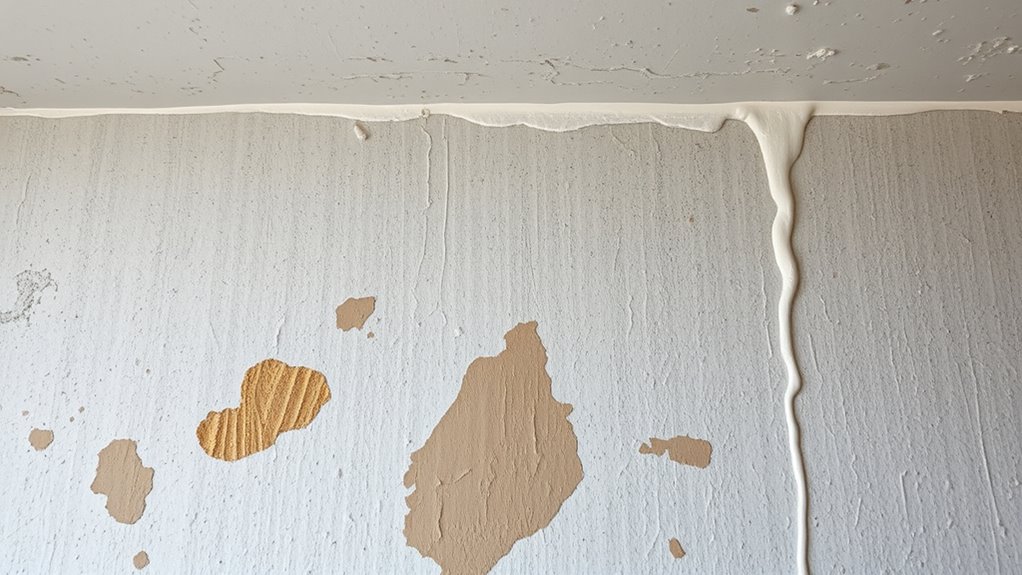
Controlling indoor humidity levels is key to preventing moisture problems and maintaining a healthy home environment. To do this effectively, you should regularly perform dehumidifier maintenance, ensuring filters are clean and units are functioning properly. This helps remove excess moisture from the air, reducing the risk of peeling paint and mold growth. Additionally, improving ventilation is vital — open windows when possible, use exhaust fans in bathrooms and kitchens, and ensure your HVAC system is well-maintained. Proper airflow prevents humidity buildup in problem areas. Incorporating proper food handling and hygiene practices can also help minimize indoor bacterial contamination that could contribute to moisture issues. For example, managing indoor humidity effectively can also support remote work productivity by creating a more comfortable environment conducive to focus. Regularly inspecting building envelopes can help identify and address potential moisture intrusion points before they cause significant damage. Leveraging AI-driven diagnostics can further enhance the detection of hidden moisture sources, making prevention more effective. Combining these strategies keeps indoor moisture levels in check, protecting your walls from damage and creating a more comfortable living space. Consistent efforts in dehumidifier maintenance and ventilation improvements are your best defense against indoor humidity issues.
Proper Surface Preparation Before Painting
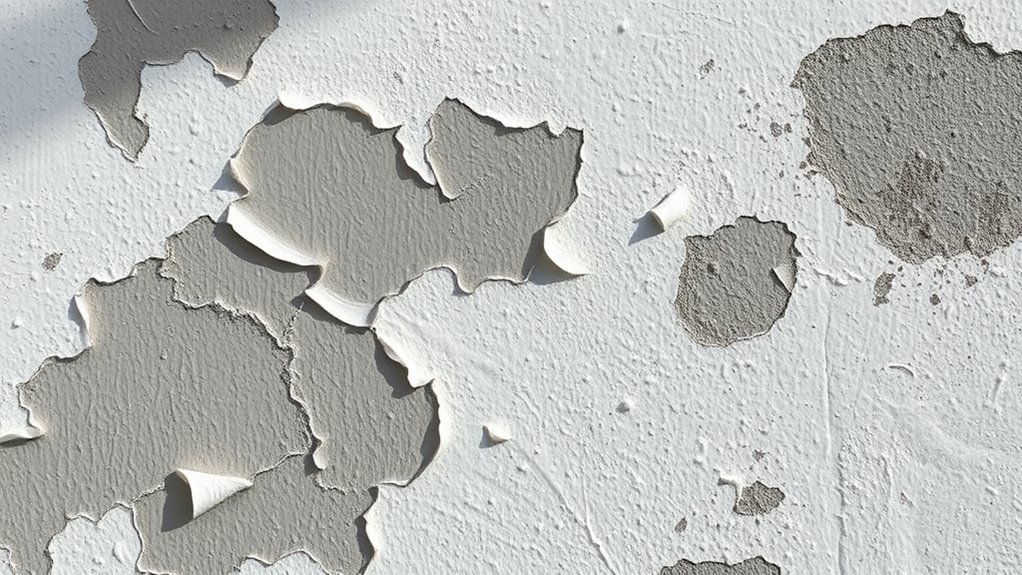
Before you start painting, it’s essential to properly prepare the surface to guarantee the best results and long-lasting finish. First, clean the wall thoroughly to remove dirt, grease, and loose paint. Sand any rough spots to create a smooth surface, ensuring better primer application. Applying a high-quality primer is vital for maximum paint adhesion and to seal moisture-prone areas. Proper surface prep prevents peeling and helps the paint last longer. Use the following table to understand key steps:
| Step | Purpose |
|---|---|
| Cleaning | Remove debris and contaminants |
| Sanding | Achieve a smooth, even surface |
| Primer Application | Enhance paint adhesion and seal surface |
Additionally, inspecting for underlying issues like moisture intrusion can prevent future peeling problems. Addressing potential moisture problems before painting ensures a durable finish and avoids costly repairs later on. Incorporating proper surface preparation techniques can significantly improve the longevity of your paint job. Using electric tools such as orbital sanders can make the sanding process more efficient and thorough.
Long-Term Strategies for Moisture-Resistant Walls

Once your walls are properly prepared and painted, focusing on long-term moisture resistance becomes key to maintaining their integrity. To achieve this, consider these strategies:
- Regularly inspect and reapply sealant to areas prone to water exposure, ensuring a watertight barrier. Sealant durability plays a vital role in maintaining the effectiveness of these barriers over time.
- Install effective wall insulation to prevent moisture from seeping through walls and reduce condensation.
- Use vapor barriers behind drywall to limit moisture transfer from outside walls.
- Maintain proper ventilation to keep humidity levels low and prevent moisture buildup.
- Be aware that signs of spoilage such as mold or discoloration can indicate underlying moisture issues that need addressing.
Implementing these steps helps protect your walls from moisture damage, reducing peeling paint and mold growth. Combining sealant application with good insulation practices offers a robust defense, ensuring your walls stay dry and durable over time.
Frequently Asked Questions
How Often Should I Check for Moisture Issues in My Walls?
You should check your walls for moisture issues at least every three to six months. Look for signs like condensation buildup or musty odors, which can lead to mold prevention problems. Regular inspections help you catch leaks or humidity problems early, preventing peeling paint and structural damage. If you notice any signs of excess moisture, address them promptly to keep your walls dry and in good condition.
Can Certain Wall Paints Help Prevent Peeling Caused by Moisture?
Sure, because who wouldn’t want superhero paints? Moisture resistant paints are your wall’s best friends—they help prevent peeling caused by moisture and keep mold at bay. These special coatings act like a shield, making sure water doesn’t sneak in and cause chaos. So, if you hate repainting every year, go for moisture resistant paints; they’re like a secret weapon for mold prevention and long-lasting, flawless walls.
What DIY Methods Are Effective for Waterproofing Interior Walls?
You can effectively waterproof interior walls with DIY sealants and moisture barriers. Start by applying a high-quality waterproof sealant to vulnerable areas, especially around seams and cracks. Then, install a moisture barrier, like plastic sheeting or specialized paint, on the walls to block dampness. Guarantee proper ventilation to reduce humidity. Regularly inspect and maintain these barriers to keep moisture out and prevent peeling paint caused by dampness.
Are There Specific Wall Materials More Resistant to Moisture Damage?
Think of your walls as armor against moisture. Water resistant drywall acts like a waterproof shield, resisting dampness and preventing damage. Ceramic tile, with its glossy surface, is a fortress against water, ideal for bathrooms or kitchens. Both materials stand strong in humid environments, ensuring your walls stay intact and looking fresh longer. Choosing these resilient options helps keep moisture at bay and your home beautiful.
How Does Climate Change Impact Indoor Wall Moisture Levels?
Climate effects lead to increased moisture fluctuations indoors, impacting your walls. As weather patterns shift, you might notice higher humidity or more frequent dampness, which causes moisture levels inside your home to rise and fall unpredictably. These fluctuations make walls more prone to damage like peeling paint. To protect your walls, guarantee proper ventilation, use moisture-resistant materials, and monitor indoor humidity, especially during extreme weather events linked to climate change.
Conclusion
So, next time you marvel at your perfectly painted walls, remember it’s probably not magic—just moisture sneaking in. Ironically, the very effort to keep your walls beautiful can backfire if you ignore the signs of excess humidity. Prevention isn’t glamorous, but it’s far more satisfying than peeling paint and costly repairs. Stay vigilant, control the moisture, and save yourself from the ironic tragedy of a freshly painted wall turning to peeling chaos.

